December 2004
The Daley News
Merry Christmas & Fruitful wishes for the New Year
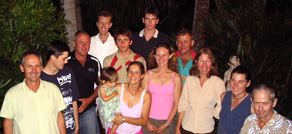
It’s nearly the end of another year and Christmas is rapidly approaching. I would like to take this opportunity to wish you all a very merry Christmas and a fruitful New Year from all the team here at Daleys. We would also like to congratulate Emma Stone on her forthcoming marriage to George over in the Solomon Islands; we wish you both a beautiful future together.
I am going to be planting myself a living Christmas tree again this year, with such a wide choice of either beautiful native pines, or the delicious pine nut it is choosing that will be the difficult part.
Creating a Dinosaur Garden
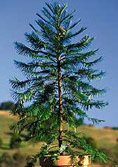 Things that are ancient fascinate me and the following plants that I have chosen for my dinosaur garden are survivors, they have outlived the giant reptiles that once fed on them and in the case of the Ginkgo tree it is the only surviving species in its genus. There is one tree that I am particularly interested in and will be adding to my garden in the near future. The Wollemi Pine, Wollemia nobilis is an ancient species considered extinct until its discovery in 1992; it is also the sole survivor of its genus. The Wollemi remains confined to a few small stands in remote and difficult terrain not far from Sydney. While I am on the subject of pines, I will begin my garden with four Australian native pine trees, the hoop pine, the bunya pine, the kauri pine and the plum pine.
Things that are ancient fascinate me and the following plants that I have chosen for my dinosaur garden are survivors, they have outlived the giant reptiles that once fed on them and in the case of the Ginkgo tree it is the only surviving species in its genus. There is one tree that I am particularly interested in and will be adding to my garden in the near future. The Wollemi Pine, Wollemia nobilis is an ancient species considered extinct until its discovery in 1992; it is also the sole survivor of its genus. The Wollemi remains confined to a few small stands in remote and difficult terrain not far from Sydney. While I am on the subject of pines, I will begin my garden with four Australian native pine trees, the hoop pine, the bunya pine, the kauri pine and the plum pine.
Hoop Pine – Araucaria cunninghamii
 This is the tallest of the native pines and it is quite capable of reaching heights of more than 40 meters making it an impressive addition to my garden. It is native to the drier rainforests from the mid-north coast of NSW through Queensland into PNG. It is a wonderful bird-attracting tree, as they love to nest in its protective prickly foliage and is an excellent host for lots of native orchid species.
This is the tallest of the native pines and it is quite capable of reaching heights of more than 40 meters making it an impressive addition to my garden. It is native to the drier rainforests from the mid-north coast of NSW through Queensland into PNG. It is a wonderful bird-attracting tree, as they love to nest in its protective prickly foliage and is an excellent host for lots of native orchid species.
Bunya Pine – Araucaria bidwillii Bush Food
 Another of Australia’s very impressive pines, it will reach a height of 40m, the crown of the tree creates an imposing silhouette and makes an interesting addition to any rainforest or bush food plantings for those with plenty of space. It also is a wonderful bird-attracting tree as it is very prickly, so it makes great habitat. It produces huge cones of edible nuts that can weigh up to 10kg, they fall from great heights so it is not
Another of Australia’s very impressive pines, it will reach a height of 40m, the crown of the tree creates an imposing silhouette and makes an interesting addition to any rainforest or bush food plantings for those with plenty of space. It also is a wonderful bird-attracting tree as it is very prickly, so it makes great habitat. It produces huge cones of edible nuts that can weigh up to 10kg, they fall from great heights so it is not  recommended to walk or park your car under a fruiting tree, this can have dangerous consequences.
recommended to walk or park your car under a fruiting tree, this can have dangerous consequences.
Kauri Pine – Agathis robusta
 This is a magnificent tree for larger gardens and parks. To me it is the most dinosaur like of our native pines; young trees have a wonderful spiral of spines that are reminiscent of stegosaurus. They will grow to around 30 meters in height but are slow growing and will look beautiful as a potted specimen for some time.
This is a magnificent tree for larger gardens and parks. To me it is the most dinosaur like of our native pines; young trees have a wonderful spiral of spines that are reminiscent of stegosaurus. They will grow to around 30 meters in height but are slow growing and will look beautiful as a potted specimen for some time.
Plum Pine – Podocarpus elatus Bush Food
 The podocarps originated in the Gondwanan forests of the Triassic period, 245 million years ago. They grew alongside araucarians, gingkophytes, cycads, tree ferns, giant club mosses and horsetails. This is a beautiful ornamental tree that will fit into my dinosaur garden perfectly; it is a large tree to 40m with delicious plum like fruits that have piney overtones. It will look stunning if kept in a large pot where the pinkish new growth can be appreciated.
The podocarps originated in the Gondwanan forests of the Triassic period, 245 million years ago. They grew alongside araucarians, gingkophytes, cycads, tree ferns, giant club mosses and horsetails. This is a beautiful ornamental tree that will fit into my dinosaur garden perfectly; it is a large tree to 40m with delicious plum like fruits that have piney overtones. It will look stunning if kept in a large pot where the pinkish new growth can be appreciated.
Maidenhair Tree – Gingko biloba
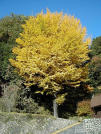 Also known as the memory tree for the herbal qualities of the leaves, it is a beautiful ornamental specimen tree suitable for parks and gardens. As it is deciduous, it will handle moderate frosts. The name maidenhair tree comes from the leaf shape that resembles the leaf of the maidenhair fern. A tea is made from the leaves and used to treat circulatory problems; the fruits are edible and much sought after in its native
Also known as the memory tree for the herbal qualities of the leaves, it is a beautiful ornamental specimen tree suitable for parks and gardens. As it is deciduous, it will handle moderate frosts. The name maidenhair tree comes from the leaf shape that resembles the leaf of the maidenhair fern. A tea is made from the leaves and used to treat circulatory problems; the fruits are edible and much sought after in its native
That completes the canopy of my garden; all these trees will look great if kept in pots but they will also outgrow them at some stage. For the under story of my garden I am planting cycads, the most primitive living seed plants that have changed very little in the past 200 million years. These ancient plants flourished in the days of the dinosaurs and are remarkable additions to any garden they are not only beautiful but they are extremely hardy with some being more than happy to endure salt spray, sandy soils, dry conditions, light frosts and full sun. Other species are happy under the canopy of rainforest as those seen on Fraser Island. There are so many different types of cycad there must be one for every type of garden. Another amazing fact is that cycads and gingko’s are the only known seed plants with swimming sperm.
Sago Palm – Cycas revolute
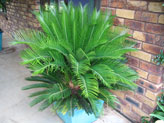 The sago palm is a very popular and ornamental cycad. It is a low growing cycad however very, very old specimens can be 6m tall with multi headed trunks. This is a versatile, tough plant that can be kept in small pots indefinitely; it makes beautiful bonsai specimens and will tolerate dry periods and light frosts. The sago palm is native to Japan and a relative of the Gingko and conifers trees. Its new growth is stunning as all the leaves emerge together in a circular pattern; they are very tender until they harden after a few weeks. It grows best in full sun.
The sago palm is a very popular and ornamental cycad. It is a low growing cycad however very, very old specimens can be 6m tall with multi headed trunks. This is a versatile, tough plant that can be kept in small pots indefinitely; it makes beautiful bonsai specimens and will tolerate dry periods and light frosts. The sago palm is native to Japan and a relative of the Gingko and conifers trees. Its new growth is stunning as all the leaves emerge together in a circular pattern; they are very tender until they harden after a few weeks. It grows best in full sun.
Burrawang Palm - Macrozamia communis
 This beautiful native cycad grows south from Armidale on the Northern Tablelands of NSW to Bega on the South Coast and inland to the Mudgee district. It naturally grows in dense colonies so I will be planting a few together in my garden. The leaves grow on top of a stout trunk that can extend under the ground as with grass trees. Plants are either male or female which is another good reason to always plant a few, this increases the chance of seeing the beautiful fruiting cones.
This beautiful native cycad grows south from Armidale on the Northern Tablelands of NSW to Bega on the South Coast and inland to the Mudgee district. It naturally grows in dense colonies so I will be planting a few together in my garden. The leaves grow on top of a stout trunk that can extend under the ground as with grass trees. Plants are either male or female which is another good reason to always plant a few, this increases the chance of seeing the beautiful fruiting cones.
Scaly Zamia – Lepidozamia peroffskyana
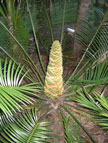 This is my personal favourite of the cycads; it has stunning shiny arching leaves up to 3 meters in length. It is native to open rainforest of north –eastern NSW and southern Queensland. It is very easy to grow but is most suited to sub-tropical areas and will look best if provided with some shade. It is a very elegant plant that can grow to about 5m, it will look fabulous in a pot and can be used indoors and out.
This is my personal favourite of the cycads; it has stunning shiny arching leaves up to 3 meters in length. It is native to open rainforest of north –eastern NSW and southern Queensland. It is very easy to grow but is most suited to sub-tropical areas and will look best if provided with some shade. It is a very elegant plant that can grow to about 5m, it will look fabulous in a pot and can be used indoors and out.
Further Reading
The Wollemi Pine – James Woodford
Tree Dinosaurs – David King
Recommended Link:
Palm and Cycad Society of Australia
Fruit Tree of the Month
The Stone Fruits
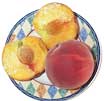 Late spring to early summer is a great time in the orchard as all the stone fruits are coming off, we have spent the last month or so trying all the different varieties and delighting in the juice running down to our elbows. I can safely say that my favourite is the Sunraycer nectarine. My own crop has been a little disappointing but I have enjoyed watching the beautiful colours of the king parrots as they have worked their way over my heavily ladened tree putting large holes in every fruit. The bowerbirds, and crows have helped them out and together they have left me with not
Late spring to early summer is a great time in the orchard as all the stone fruits are coming off, we have spent the last month or so trying all the different varieties and delighting in the juice running down to our elbows. I can safely say that my favourite is the Sunraycer nectarine. My own crop has been a little disappointing but I have enjoyed watching the beautiful colours of the king parrots as they have worked their way over my heavily ladened tree putting large holes in every fruit. The bowerbirds, and crows have helped them out and together they have left me with not 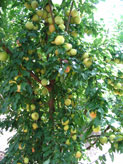 a single fruit. Oh well there is always next year when I am going to try bagging the individual fruits. The control of the other eaters is the main problem facing the stone fruit grower, as everything loves them, apart from this they are easy trees to grow in the backyard and can be trained to fit any space.
a single fruit. Oh well there is always next year when I am going to try bagging the individual fruits. The control of the other eaters is the main problem facing the stone fruit grower, as everything loves them, apart from this they are easy trees to grow in the backyard and can be trained to fit any space.
There is a stone fruit to suit every one, they come in all sizes and there are so many interesting crosses that choosing only one or two can be the most difficult hurdle. The smallest of these trees is the dwarf peach, this is a delightful little tree perfect for a small garden or it will always look lovely in a pot on a patio. It looks gorgeous as a standard tree and produces full sized fruit with great flavour. It can also be grown purely for its ornamental qualities, with its deep green bushy form it looks great and puts on a lovely spring blossom show. Some of the more unusual stone 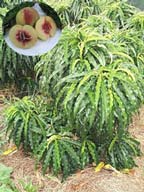 fruits are the plumcot (plum x apricot) and peachcot (peach x apricot). With deliciously blended flavours they enhance any orchard.
fruits are the plumcot (plum x apricot) and peachcot (peach x apricot). With deliciously blended flavours they enhance any orchard.
A garden with small spaces is of no problem to growing stone fruits, they are happy to be espaliered, trained like this they will always look wonderful and amaze anyone who sees how productive and beautiful a fence can be. Be aware when choosing plums as most require cross pollination and they will all benefit from it, there is nothing more frustrating than waiting years for your tree to fruit only to realize that it requires another tree in order to set fruit.
All the stone fruits look beautiful in flower in the springtime and as I have said are great attractors of birds and wildlife. 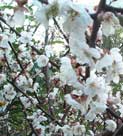 Do not be put off by the threat of fruit fly, yes they will attack stone fruits but there are simple organic means of control that include the bagging of the fruits in individual bags. This may sound time consuming but it is worth the effort and the bags can be reused. The result is a crop that is protected not only from the flies but also the birds and the bats.
Do not be put off by the threat of fruit fly, yes they will attack stone fruits but there are simple organic means of control that include the bagging of the fruits in individual bags. This may sound time consuming but it is worth the effort and the bags can be reused. The result is a crop that is protected not only from the flies but also the birds and the bats.
There is a wide range of trees to suit all climatic regions with low chill tropical and self-pollinating varieties.
Further Reading:
Common Questions to growing Stonefruit in the Subtropics
Organic Fruit Fly Control





